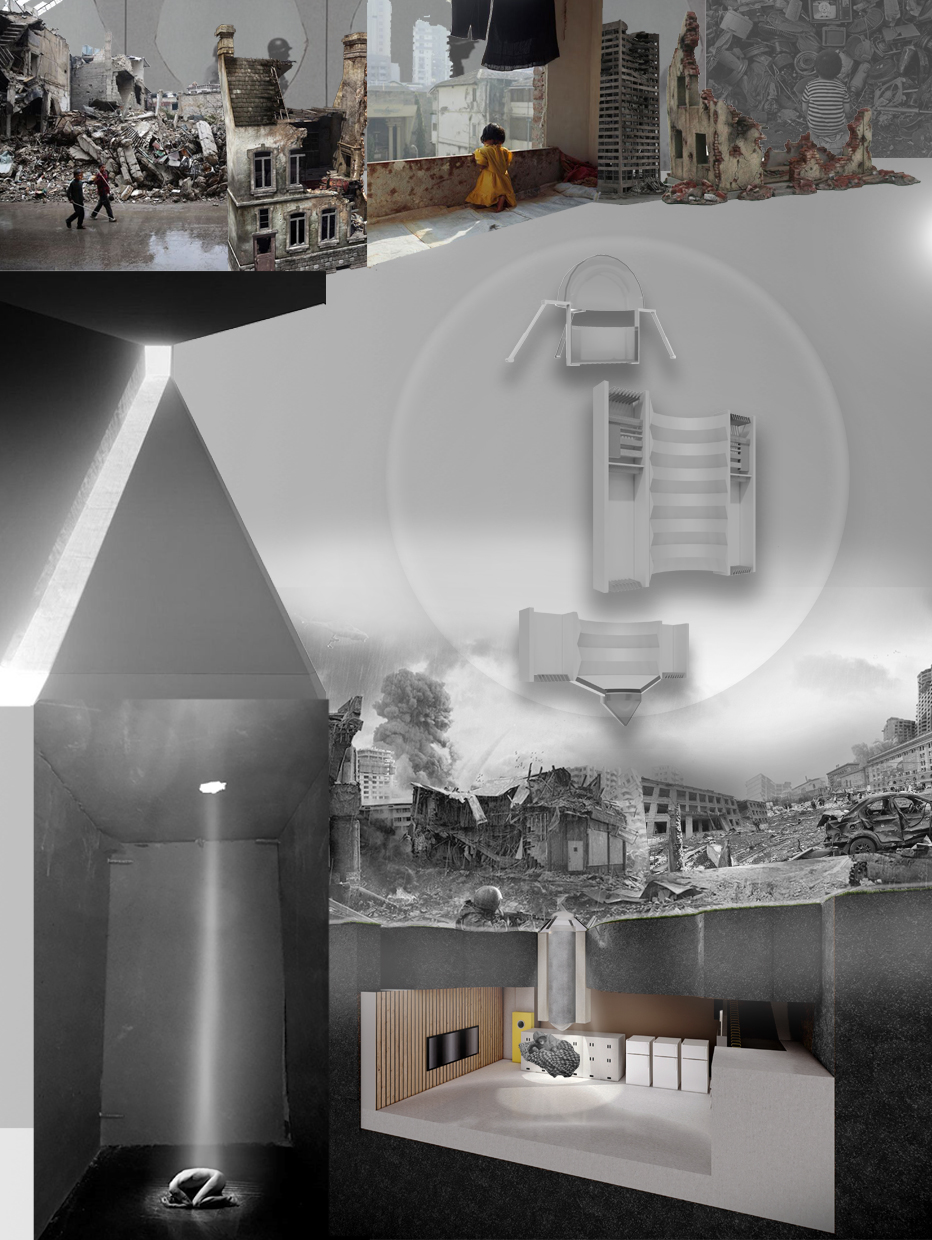THE LIGHT OF HOPE FOR UNDERGROUND SHELTERS

Category
Daylight investigations - Region 2: Central and Eastern Europe and the Middle East.
Students
Büşra Yılmaz
Fatih Buğra Kuzdere
Pakize Kılıç
Mehmet Sefa Yakut
Bekir Yılmaz
School
Necmettin Erbakan University
Country
Turkey
Download
Download ↓
2022 INTERNATIONAL VELUX COMPETITION
“THE LIGHT OF TOMORROW”
Problem description: Underground structures, which are the most reliable places for housing civilians in a war zone, are inadequate and unqualified in terms of lighting and ventilation/fresh air. Therefore, it has been chosen as the most important design problem that needs to be solved urgently.
Location of the problem area: Ukrainian war zone.
General information about the Russian war in Ukraine: According to a report from the United Nations (UN), at least 1611 civilians were killed in the military operation launched by Russia in 2022. 2227 civilians were injured and at least 4 million 219 thousand people have migrated to other countries as refugees. The International Organization for Migration (IOM), linked to the UN, reports that 7.1 million civilians have been displaced within Ukraine, together with refugees who have reached neighboring countries, to 11 million. It was stated that most of the civilian casualties were caused by the use of explosive weapons of varying effects, including bombardments and air strikes Many people in the Ukrainian capital still seek refuge underground, where they appear to be safest. As Russian forces approach the capital, many Ukrainian civilians seek refuge in subway stations that date back to the Soviet era. Subway stations, underground garages, and basements of buildings are full of people trying to protect themselves from bombs and missiles that threaten their lives. In this regard, shelters are of great importance as reliable hiding places. From the conclusions of the conducted analysis, civilians staying in above-ground structures on the battlefields are in great danger. Analysis has shown that civilians living in battlefield shelters face three main problems:
1-Daylight 2-Clean water 3-Fresh air.
In addition to the problem of civilians not being able to use daylight on battlefields, people in the region also suffer from severe light problems because of the Russian attack on power plants.Project Research and Documentation Methods: The project has been researched and documented with a vigorous literature survey on the subject area, in addition it has included review of all news, local and international reports on Ukrainian-Russian war area, including the needs of victims, among which lighting the underground shelters is an important problem to be solved.
Contemporary and Future Challenges of the Project Idea: In this project idea the design is considered to be both easy to apply and transferable from the specific Ukrainian example to the entire war zone and must not endanger the lives of innocent people. There are two stages of the design. In the first one, the impact-resistant ballistic transparent part is opened in the upper layer above the ground to take advantage of the condensation caused by the fact that it is safer at night and the temperature is lower than during the day. This opened ballistic transparent layer, thanks to the surface area increased by the glass spheres, collects the condensed air generated by the wind blowing near the ground and captures it by filtering in its first chamber. In addition, channels are opened on both sides of the light tube to allow natural air to enter. The chemical is passed inside through various air filters that prevent the transport of dust. Thus, when the system is left open, both water is introduced into the first chamber, fresh air is drawn in, and the need for fresh air inside is met.
In the second stage of the design, the upper solid layer is closed with the onset of daylight and the warmth of the sun. With its closure, direct sunlight begins to fall on the water accumulated in the first chamber. Thanks to the light-shielding and refractive properties of the glass spheres and the labradorite stone, which is located between them, the daylight is absorbed. It is directed to the reflective surfaces inside the light tube. As the temperature rises, the filtered water in the first chamber evaporates and moves through the channels toward the lower chamber. After it sinks into the lower chamber, the water is recaptured with the condensed water vapor in the main chamber. Users in the shelter can use the water collected here. In addition, by using the reflectivity of the water in the reservoir, daylight is used most efficiently and it is naturally directed into the shelter.The Level of Experimentation and Innovation of the Project Idea: The design proposal of this study is being considered to meet the daylight, fresh air, and clean water needs of civilians in underground structures/shelters in war zones. Thus in this research a new lighting mechanism with a triple system solving the problems of light-air-water are combined together for underground shelters and similar structures. This is the main experimentation and innovation of the project idea. Ukraine war zone is selected as the case area for the urgent application of this project idea.

































